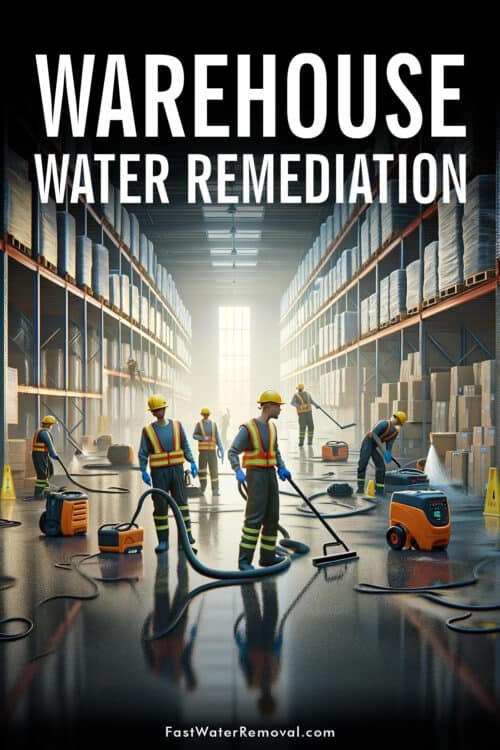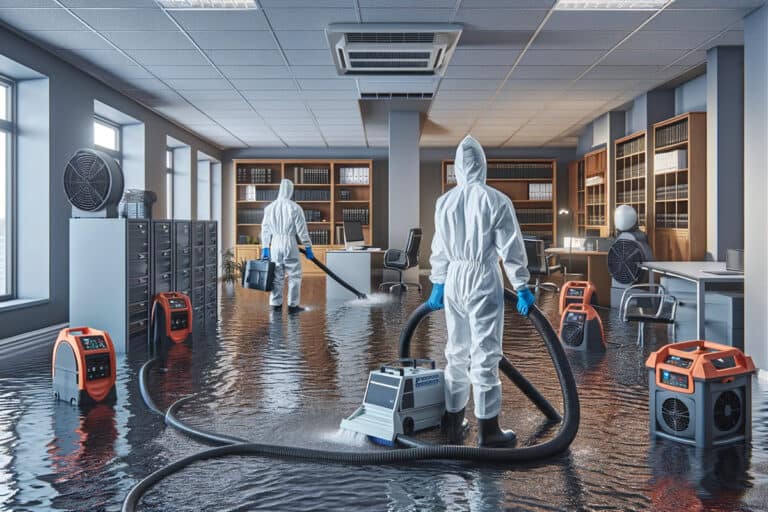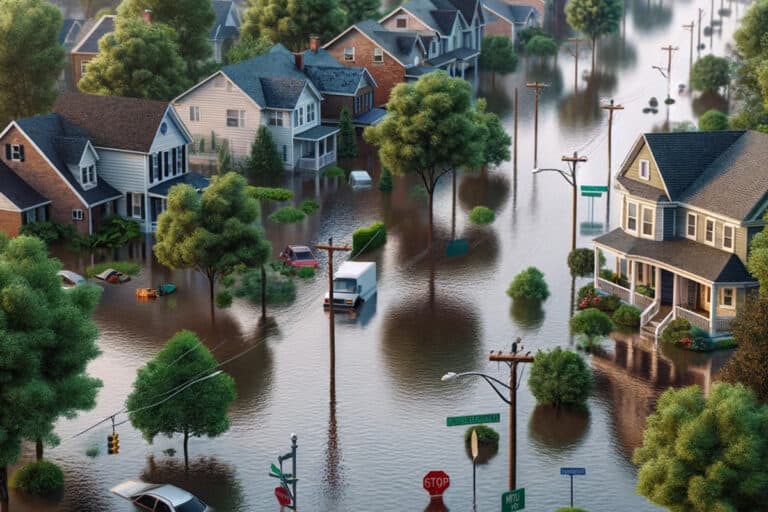Disclosure: I am compensated for purchases made through some links on this site. Click for details.
Warehouse water remediation is a critical concern for facility managers and property owners, necessitating prompt and effective action to mitigate damage and maintain operations. Water damage within a warehouse can stem from various sources, such as natural disasters, plumbing failures, or fire suppression systems, leading to commercial property damage. Addressing this type of emergency not only involves water removal but also the consideration of potential contaminants and the safety of stored goods.
Successful remediation of water damage in warehouses includes identifying the source of moisture, assessing the extent of the affected area, and implementing systematic procedures to dry out and restore the facility. The process is multifaceted, encompassing immediate measures to prevent further damage, longer-term restoration activities, and planning to minimize future risks. Engaging with experienced professionals who comply with regulatory standards and have knowledge of financial and insurance considerations ensures a comprehensive approach to warehouse water damage recovery.
Key Takeaways
- Effective warehouse water remediation is essential to protect assets and maintain business continuity.
- A systematic approach to remediation involves immediate action, thorough assessment, and proper repair.
- Professional assistance ensures regulatory compliance and helps in managing the financial implications of water damage.
Understanding Warehouse Water Damage
Warehouse water damage can result in significant financial losses and operational disruptions. It is imperative to understand its causes and types and to accurately assess the extent of damage to maintain the structural integrity and safety of the facility.
Causes of Water Damage
Water damage in warehouses can arise from various sources, including plumbing issues like leaks or burst pipes. Poor drainage systems or cracks in the foundation also contribute to moisture accumulation. During severe weather conditions, roofs and walls may fail, leading to storm flooding that can overwhelm the capacity of drainage systems and result in a flooded warehouse.
Types of Water Damage
Warehouse water damage is often categorized by the nature and source of the water. Clean water damage involves water from pipes or leaks that pose no immediate health risk, whereas water that contains contaminants, like that from a faulty plumbing network, can be more destructive. Furthermore, damage from external sources, like natural disasters, can carry harmful agents and debris, compromising the facility’s safety.
Related Content: The 3 Categories of Water Damage: What You Need to Know
Assessing the Extent of Damage
A thorough assessment should be conducted to determine the impact on a warehouse’s interiors and structural components. Inspections might reveal water-damaged interiors, including compromised walls or flooring. Industrial hygienists or remediation professionals typically assess moisture levels and conduct a full inspection of the plumbing and structural integrity to guide the remediation process.
Initial Response to Water Emergencies
In the event of a water emergency in a warehouse, immediate action is essential to prevent further damage and ensure safety. A well-coordinated initial response can significantly mitigate risks and set the stage for effective water extraction and property restoration.
Safety Protocols and Hazards
Safety must be the foremost priority when handling a water emergency. Warehouse personnel should be familiar with OSHA guidelines for responding to water incidents, which include identifying electrical and chemical hazards. Before any cleanup efforts begin, utilities such as electricity should be shut off to prevent electrocution risks. All staff must adhere to safety protocols to avoid injuries or secondary damage to the property.
Emergency Mitigation Steps
Upon identifying a water emergency, immediate mitigation steps must be followed to limit water exposure and structural damage. Creating a contingency plan before an incident can expedite the emergency response. Key actions include isolating the source of water intrusion, protecting undamaged inventory, and placing barricades to prevent the spread of standing water. These steps are integral to stabilizing the environment before beginning major extraction efforts.
Water Extraction Processes
The process of water extraction should commence as swiftly as possible after mitigating initial safety hazards. Using industrial-grade water extractors, professionals can efficiently remove standing water from the affected areas. Post-extraction, it’s important to address moisture with dehumidifiers and to deodorize the space to prevent mold growth and ensure a thorough restoration. This stage is crucial for returning the warehouse to its pre-emergency state.
Water Remediation Procedures
Water remediation in warehouses is essential to maintain the structural integrity of the facilities and the safety of stored goods. It involves systematic procedures using specialized equipment to ensure thorough drying, mold remediation, and disinfection. These measures are critical to prevent long-term damage and to safeguard the health of individuals who frequent these spaces.
Drying and Dehumidification
The first phase in water remediation is to remove moisture through structural drying and dehumidification. Restoration professionals employ industrial-grade dehumidifiers and air movers to rapidly dry out all affected areas, including hidden spaces where moisture can accumulate. Consistent monitoring with moisture meters ensures that desired dryness levels are achieved and maintained to prevent mold growth.
Related Content: Dehumidifier Rental: Your Guide to Cost-Effective Humidity Control
Remediation of Mold and Mildew
Following water damage, mold and mildew can develop quickly, creating the need for immediate mold remediation. Remediation experts isolate the affected areas to prevent spore spread and use HEPA filtration systems to remove airborne mold spores. Infected materials are either treated with antimicrobial agents or, if severely compromised, removed and replaced to uphold stringent remediation standards.
Disinfecting and Preventing Future Growth
The final step includes disinfecting the area to kill any lingering bacteria or viruses, using EPA-approved biocides that are safe for the environment. Restoration teams also advise on repairs and improvements, such as waterproofing and installation of moisture barriers, to prevent future water intrusion. Continuous maintenance and monitoring are essential to ensure a dry and mold-free warehouse environment.
Damage Restoration and Repair
When a warehouse experiences water damage, immediate action is needed to repair the facility’s infrastructure, restore inventory, and perform a thorough cleanup. The complexity of water damage in such industrial settings requires a systematic approach by an experienced restoration company to minimize the repair bill and ensure the facility returns to operational standards as swiftly as possible.
Warehouse Infrastructure Repair
Water damage can weaken the structural integrity of a warehouse. A professional damage restoration team will assess the extent of repair work needed on components such as walls, flooring, and support beams. Restoration efforts must comply with building codes to ensure the safety and stability of the facility.
Inventory and Stored Goods Restoration
Stored merchandise and inventory are often the lifeblood of a warehouse’s operation. Water damage can lead to significant financial losses due to inventory spoilage. A restoration company will prioritize salvageable goods, employ specialized drying methods, and coordinate the disposal of irreparably damaged items, all while meticulously documenting the process for insurance purposes.
Final Restoration and Cleanup
The last phase of the water remediation process involves a detailed cleanup to prevent mold and further damage. The restoration company ensures that the storage environment is completely dry, sanitized, and ready for operation. Final inspections and touch-ups are performed to ensure that the facility meets industry standards for cleanliness and safety.
Insurance and Financial Considerations
Navigating insurance and financial factors is critical in the aftermath of commercial water damage. Prompt and detailed documentation along with a clear understanding of restoration costs helps businesses interact effectively with insurance companies.
Documenting Damage for Insurance Claims
When commercial properties suffer water damage, the documentation process must begin immediately. They should capture everything from furniture to structural damage in photographs and video recordings. This visual evidence, accompanied by an itemized list of damaged property, bolsters the legitimacy of insurance claims.
Working With Insurance Companies
Dealing with an insurance company requires patience and persistence. Restoration companies often assist in this process, ensuring that all damage is properly reported and claims are filed per insurance policies. This collaboration can significantly streamline the claim process and prevent disputes over the extent of the property damage.
Estimating Restoration Costs
An accurate estimate is essential for both the insurance claim process and budgeting for repairs. Restoration companies typically provide detailed quotes that cover all aspects of water damage remediation. These estimates include the costs for drying out the premises, repairing structural damage, and restoring or replacing furniture and interior items.
Planning and Prevention
Effective water remediation in warehouses begins with proactive measures that foresee potential issues and implement strategies to prevent them. Planning and prevention are key to ensuring that a warehouse’s integrity and its contents are safeguarded against moisture and water damage.
Facility Assessment and Maintenance
Regular facility assessments are essential for identifying risks such as weak roofing or potential plumbing issues. A thorough assessment enables maintenance crews to attend to necessary repairs before they escalate. For example, ensuring that roof drainage systems are clear of debris prevents overflow and leaks, safeguarding stock and infrastructure.
Designing Contingency Plans
Every warehouse should possess detailed contingency plans for various water-related emergencies. These plans are crafted by professionals, delineating precise actions to re-route water, address immediate damages, and minimize operational disruptions. Training staff in emergency protocols ensures a quick and efficient response, thus effectively preventing extensive water damage.
Infrastructure Upgrades and Waterproofing
Investing in infrastructure upgrades and waterproofing measures is a proactive approach to prevent water ingress. Installing water barriers and improving seals can greatly reduce the risk of moisture penetration. Additionally, upgrading to robust plumbing systems and inspecting them regularly can prevent leaks and other water-related issues in a warehouse.
Regulatory Compliance and Professional Assistance
In navigating warehouse water remediation, adherence to regulatory standards and engagement with professional services are crucial. Entities should ensure they meet Environmental Protection Agency (EPA) and Occupational Safety and Health Administration (OSHA) benchmarks while enlisting expert restoration professionals for effective outcomes.
Adherence to EPA and OSHA Standards
The EPA establishes guidelines for water remediation, ensuring that efforts not only rectify immediate issues but also protect public health and the environment over the long term. Alongside this, they must comply with OSHA regulations, which encompass worker safety during the remediation process.
Hiring Professional Remediation Services
Engaging with a restoration company brings specialized expertise to warehouse water remediation tasks. These restoration professionals understand industry-leading practices and can provide inspection, reporting, and monitoring services to maintain compliance and operational efficiency. They often operate on a multi-facility, national basis, ensuring consistent standards across various locations.
Long-Term Recovery and Resilience Building
Long-term recovery in warehouse water remediation is pivotal for maintaining operations and ensuring asset protection. Building resilience into the structure and workflow minimizes future disruptions and reduces structural damage risks, enabling warehouses to continue serving their critical function in supply chains.
Improving Structural Resilience
Structural resilience is the first line of defense against water-related catastrophes. A robust design incorporates elevation of sensitive equipment, utilization of water-resistant materials, and integration of water-removal systems to facilitate rapid response in case of water ingress. For warehouses located in flood-prone areas, flood barriers and reinforced foundation structures are essential to mitigate the risk of structural damage and water infiltration.
Future-Proofing Against Water Damage
To future-proof a warehouse against water damage, one needs to anticipate the challenges posed by climate change and water-related disasters. Climate modeling can inform design standards, ensuring infrastructure is built to withstand projected weather patterns. Incorporating green infrastructure, like bio-swales or rain gardens, can help manage excess water while water-sensing technologies and automated shut-off systems proactively detect leaks or floods to prevent extensive water damage.
Conclusion
Effective warehouse water remediation is a comprehensive and critical process that requires immediate action, thorough planning, and the collaboration of experienced professionals. From the initial emergency response to the long-term strategies for building resilience, each step is essential to mitigate damage, ensure safety, and maintain operational continuity.
Adherence to regulatory standards, such as those set by the EPA and OSHA, alongside engaging with specialized restoration services, plays a vital role in navigating the complexities of water damage and recovery.
By implementing systematic remediation procedures, conducting regular facility assessments, and investing in infrastructure upgrades and preventive measures, warehouse managers can safeguard their assets against future water-related emergencies.
Ultimately, the goal is to restore the warehouse to its pre-damage state efficiently, minimize financial impact, and enhance the facility’s resilience against potential water damage, ensuring the warehouse continues to function as a critical component of the supply chain ecosystem.





